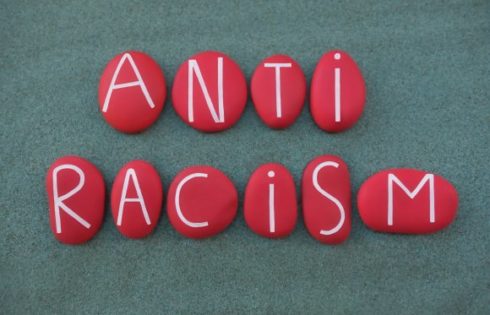
Last month the Anti-Defamation League filed an amicus curiae brief defending racial preferences at the University of Texas ahead of an upcoming Supreme Court decision. In so doing, the nation’s most prominent Jewish civil liberties group has shamefully betrayed its longstanding commitment to equal treatment for all. It has also ignored the very long tradition of discrimination in academia against the “new Jews,” Asian-Americans.
Meanwhile, the brief against the university filed by four groups—among them three Asian-American advocacy organizations—cites the history of Jewish exclusion at the nation’s top schools in an appeal to end current race-based admission practices. “Every facet of the discrimination that Asian-Americans face today in college admissions has been reflected in the Jewish experience,” says Israeli-born Alan Gura, the brief’s author. Kenneth Marcus, president of the Louis D. Brandeis Center for Human Rights Under Law, which signed onto the brief, agrees. “It wasn’t right for the elite colleges to limit Jewish students then, it’s still not right to limit Asian-American students now.”
The parallels between the Jewish and Asian experiences are striking. As with the Jews who applied to the nation’s top colleges with fake names, Asian-American students applying to many colleges are encouraged to stress “non-Asian” attributes like student government, not playing the violin. Those that are half-Asian, half-white are encouraged by college counselors to list themselves as white, while the Princeton Review Student Advantage Guide warns Asian-American not to check that race box at all or send a photo. “After 10 years of [college counseling] and 4 years in Dartmouth admissions, I don’t think it’s intentional, but I think there is discrimination,” admits former admissions officer Michele Hernandez.
Asian Americans have now “inherit[ed] the mantle of the most disenfranchised group in college admissions,” writes Daniel Golden, author of Price of Admission. “The nonacademic admission criteria established to exclude Jews, from alumni child status to leadership qualities, are now used to deny Asians.” The joint brief draws on the history of discrimination as recounted in Jerome Karabel’s The Chosen: The Hidden History of Admission and Exclusion at Harvard, Yale, and Princeton (2005), which finds that many of the practices we consider legitimately integral to the college admissions process—the interview, teacher recommendations, concerns about “leadership” and athletic ability, geographic diversity—were means of screening out Jews and other “undesirables.” Dartmouth president Ernest Hopkins once warned that “any college which is going to base its admissions wholly on scholastic standing will find itself with an infinitesimal proportion of anything else than Jews eventually.”
Colleges even held conferences on how to deal with the “Jewish problem” in the early 1900s. At Princeton, Yale, and Harvard, the combined Catholic and Jewish population was kept to 5, 15, and 7 percent respectively. At Harvard, President A. Lawrence Lowell later called for an explicit Jewish quota of 15 percent. When that failed, the admissions committee proposed and Harvard adopted the “top-seventh” rule, under which any boy who graduated in the top seventh of his class would be eligible for admission. Though it was intended to limit Jewish enrollment while producing more Southern and Western Harvard men, it wound up allowing a large percentage of Jews—27 percent of the entering class in 1925—and was scrapped by Lowell and the Board of Overseers in favor of a new plan which would consider subjective criteria like “character” and “leadership.” Today the euphemistic emphasis at Harvard and many other highly selective schools is on “holistic” admission, which really means that college admissions officers can admit whomever they like.
The University of Texas rule that automatically admits applicants in the top 10 percent of their high school class even recalls Harvard’s top-seventh rule. After the Fifth Circuit Court of Appeals banned the consideration of race in admissions in 1996, Texas’s public universities implemented the 10 percent standard as a sort of end run to ensure more black and Latino admissions. As Texas schools are de facto largely segregated, with some high schools overwhelmingly white and others overwhelmingly minority, the hope was that this criterion would achieve the desired racial diversity. But the plan backfired because white and Asian parents increasingly gamed the system by picking less competitive high schools for their children. Though the percentage of Hispanics and blacks system wide increased marginally under the new plan, it didn’t keep up with the Latino and black increase in the overall population. Texas began using racial preferences again in 2004, after the Supreme Court ruled in the Michigan affirmative action cases that race could sometimes be considered. The Supreme Court will revisit race-based admissions again in October, in Fisher v. University of Texas.
In every state where racial preferences in college admissions have been eliminated—California, Texas, Florida—Asian-American enrollment has increased. Caltech, which refuses to consider race, is one-third Asian, while the University of California-Berkeley, barred by law from considering race, is more than 40 percent Asian. There’s little doubt (and much worry) that if the informal quotas were dropped at the nation’s top private universities and colleges, Asian-American enrollment would swell there, too. Princeton sociologist Thomas Espenshade has found that to be considered at elite institutions Asian-Americans needed a 1550 SAT score (out of 1600) just to be competitive with blacks who had an 1100 or whites with a 1410.
UT’s argument that blacks and Latinos are “underrepresented” on campus, if taken to its logical conclusion, would mean that Jews, who often make up a plurality and in some cases a majority of elite American campuses, could find themselves barred from admission in order to correct their “overrepresentation.” A survey of Jewish political opinion in 1989 by Steven M. Cohen of Hebrew Union College found that Jews are more conservative on racial preferences than on other issues and compared to the general population, but in recent years that attitude has softened. Race-based admission doesn’t burn as hot as it once did, because Jews have been so successful in the admissions process. “We feared that our hard-earned right to be admitted on the merits would be taken away,” explained Alan Dershowitz in 2002. “The WASP quotient would be held constant, and the Jews and African Americans would be left to fight over the crumbs. What happened is that Jews have become the WASPs. They are among the dominant groups on campus, in terms of numbers.”
Now that Jews have been so successful in higher education, the thinking goes, they can relax a little. The American Jewish Committee and the American Jewish Congress reversed their longstanding opposition to race-based admissions and endorsed such preferences in 2002, before filing amici briefs in the Michigan cases. The Anti-Defamation League, to its credit, still opposed them. It was “sticking to its ‘principled position’ that people should not be judged by skin color and any use of race in admissions is unconstitutional,” the ADL’s National Director, Abraham Foxman told the Washington Post at the time. His predecessor, Nathan Perlmutter, had once called for a ban on all race-based criteria. “It was bad when Jews and blacks were victims. And it is equally bad when whites are victims,” he argued. “No one should be discriminated against.” But now the ADL has fallen for the ruse that the consideration of race in admissions isn’t a quota. The Texas plan “is not an overt or a covert quota system, which ADL would have opposed,” Foxman and Robert Sugarman, the ADL’s chairman, explain in a press release. But perhaps Jews have reason to worry. If there are “underrepresented” minority groups on campus, it follows that there are “over-represented” ones too.
That may well happen sooner than the ADL thinks. In May administrators at the City University of New York created a new minority group to be identified in the hiring process, “White/Jewish,” raising fears among Jewish professors that there is a movement afoot to limit their overall numbers in the interest of increased racial diversity. The controversial move drew the interest of Democratic state Assemblyman Dov Hikind, who called the new category “abhorrent.” “I think it goes to the idea of ‘We have enough of this group, let’s get more of that group,’” Hikind told the New York Post. “Diversity is a wonderful thing, but I think the university should hire the best and most qualified educators. If that means all professors are Asian, so be it.”
Jewish organizations should follow Hikind’s lead and expose these new diverse policies for the informal quotas that they are. When it comes to the arbitrary admissions’ policies, the ADL ought to heed the aphorism of America’s first Jewish Supreme Court justice, Louis Brandeis. “Sunlight is the best disinfectant.”
Fix Contributor Charles C. Johnson graduated from Claremont McKenna College in 2011. He is a member of the editorial board of The Orange County Register, and is author of a forthcoming political biography of Calvin Coolidge (Encounter Books, 2013).
(IMAGE: Kijkwizer, Wikimedia Commons)
Click here to Like The College Fix on Facebook.




Please join the conversation about our stories on Facebook, Twitter, Instagram, Reddit, MeWe, Rumble, Gab, Minds and Gettr.